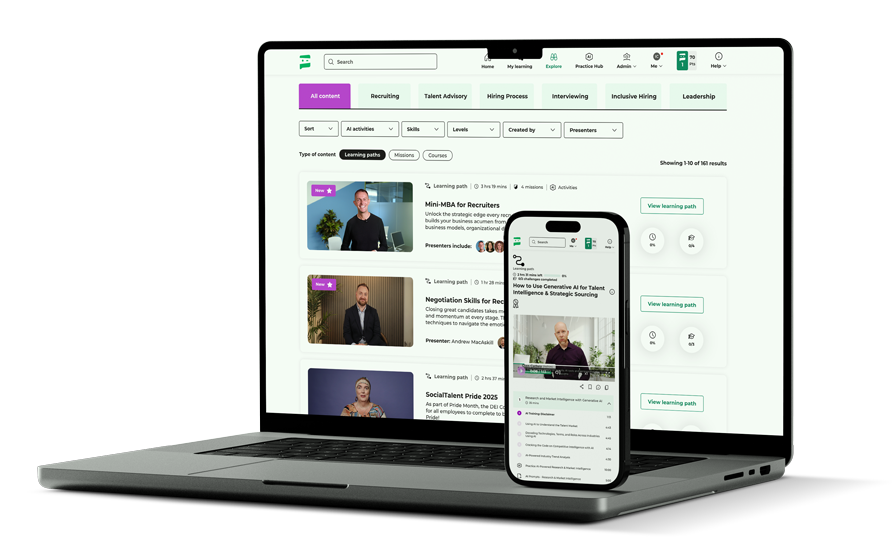
By David Deady
A step-by-step guide for hiring managers who want better results without wasting time.
Let’s get this out of the way: unicorns don’t apply for jobs.
You know the type. The mythical candidate with 10+ years of experience, every credential under the sun, fluent in five frameworks, and somehow willing to work under pressure and smile through it.
Too many job ads are written to attract unicorns. And as a result, they fail.
The real problem? Many hiring managers still treat writing job ads as a box to tick – an annoying bit of admin to rush through once the headcount is approved. But in reality, writing an effective job ad is one of the most strategic things you can do. Done well, it helps you sell the opportunity, attract the right candidates, and set the stage for a smoother, more successful hiring process. It is not something just siloed to recruiters.
Let’s walk through a better way – one that doesn’t just get you more applicants, but the right ones. Based on Aubrey Blanche-Sarellano’s amazing SocialTalent mission on ‘Effective Hiring‘, this is an essential read for hiring managers of all levels.
Step 1: Define the Gap Before You Fill It
Don’t hire for a role you haven’t scoped.
Before you write a single word of your job ad, pause and ask: what exactly is this role going to accomplish?
Start by reflecting on your team’s mission. Where are you falling short? Where are you stretched too thin? The gap you’re trying to fill might be one of capacity, skills, or both. Either way, your first job is to list out all the responsibilities that need to be taken care of – not the tasks, but the outcomes.
Once you have that list, filter it down to what isn’t currently being handled. These are your gaps. Then group those responsibilities at the right level: think “onboarding new hires” instead of “entering names into the HR system.” This helps you avoid building a role that’s either too broad or too jumbled to succeed.
A coherent role starts with a coherent need.
Step 2: Focus on Skills, Not Just Experience
Hire for potential, not repetition.
Once you’ve got your list of responsibilities, it’s time to break them down into the skills needed to do the job well. Not titles. Not years. Skills.
Skills – also called competencies – are the building blocks that allow people to solve problems, manage tasks, and collaborate effectively. And they’re transferable. Someone who hasn’t held the exact title you’re hiring for might still be the best person for the job if they’ve built the right skills in another context.
Let’s say you’re hiring for a team lead. Instead of saying “must have 5+ years leading teams,” ask:
- Can they coach?
- Can they give constructive feedback?
- Can they support people’s growth?
If the answer is yes, that’s what matters.
Pro tip: Aim to identify two to three key skills for every major responsibility in the role. And if your company has a competency library – use it! It’ll help you stay consistent and focused.
Step 3: Be Ruthless With Requirements
Six must-haves. That’s it.
It’s tempting to list every possible skill and qualification you’d like a candidate to have. But here’s the truth: the longer your list, the smaller and less diverse your talent pool becomes.
Did you know?
- Women are likely to apply only when they meet 90% of listed requirements.
- Men? Just 40–60%.
The more you pile on, the more you incentivize confidence over competence. That means you could be missing out on incredible candidates – especially those from underrepresented backgrounds.
Here’s your new rule of thumb:
- No more than 6 “must-have” requirements
- Plus 3–4 “nice-to-haves”
If you’re struggling to cut down your list, your role is probably scoped too wide – or you’re thinking at too granular a level.
Less is more. And clarity wins.
Step 4: Write Like a Marketer, Not a Taskmaster
Sell the job. Don’t list chores.
Now comes the fun part: the actual ad.
Most job ads sound like this:
“We’re looking for an experienced account manager to liaise with clients and drive revenue for strategic accounts.”
Yawn.
Now try this:
“In this account management role, you’ll collaborate with senior stakeholders to showcase our product’s value and drive growth across a portfolio of strategic accounts.”
See the difference? One reads like a job description. The other sells the opportunity.
Think of your ad as a marketing document. You’re not just listing duties – you’re telling a story:
- What makes this job exciting?
- What impact will the candidate have?
- What’s unique about your team, your culture, your mission?
And don’t forget the benefits. In today’s competitive market, candidates want to know about growth opportunities, work-life balance, flexibility, and values alignment. These matter just as much as the role itself.
Aubrey puts it best in her SocialTalent course:
“An effective job ad doesn’t just outline what the job is – it highlights the opportunity it represents, the problems to solve, and the growth it offers. That’s what candidates want to see.”
Learn more: How to Use ChatGPT to Write Job Ads
Conclusion: Write Less, Attract More (of the Right People)
Writing an effective job ad isn’t about adding more – it’s about being intentional.
Take the time to understand what you truly need. Translate that into skills, not laundry lists. Write with purpose and persuasion. And you’ll attract fewer, better candidates – and make your hiring process smoother, faster, and far more successful.
Because when you stop chasing unicorns, you start spotting real stars.
Want to go deeper?
Learn how to build inclusive, effective hiring practices with expert-led courses on the SocialTalent platform – including content from Aubrey Blanche-Sarellano on effective hiring, team development, and more.




